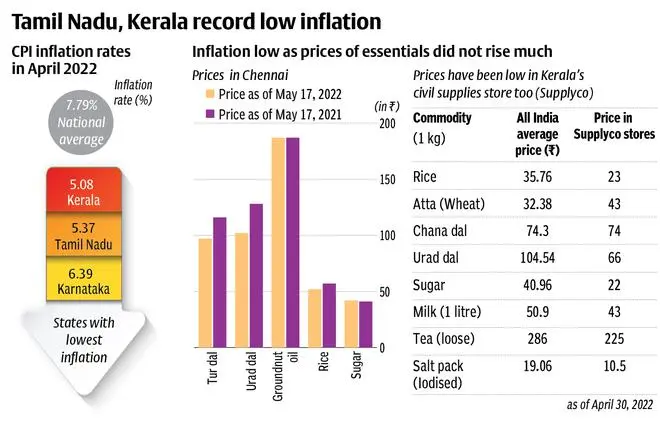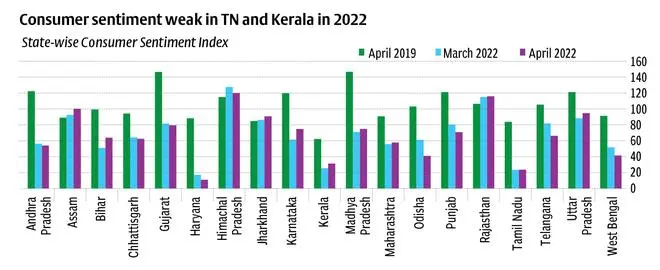The national average CPI inflation for April 2022 has shot up to 7.79 per cent from March’s 6.2 per cent. However, it will be wrong for one to assume that the inflation is uniform across the country. While the April 2022 inflation figure is as high as 9.12 per cent, 9.02 per cent and 8.98 per cent in West Bengal, Telangana and Haryana respectively, it is just 5.37 per cent for Tamil Nadu and 5.08 per cent for Kerala.

Other States with inflation lower than all-India rates in April 2022 are Uttarakhand, Punjab, Karnataka, Himachal Pradesh, Andhra Pradesh, Bihar, Chhattisgarh and Delhi.

The most well-known indicator of inflation is the Consumer Price Index (CPI), which measures the percentage change in the price of a basket of goods and services consumed by households.
Kerala’s inflation rate has been lower than all other states, as well as the national average since the beginning of the pandemic but Tamil Nadu’s inflation dipped below the national average since January 2022.
In the pre-pandemic period, States with higher GSDP per capita recorded higher inflation and States with lower per capita income recorded lower inflation. Kerala and Tamil Nadu had consistently recorded CPI reading above national average before the pandemic. So, what has changed now?
Game changing for TN?
Many factors can contribute to low CPI, but in TN, a lower reading in 2022 appears to be primarily due to the smaller price hike on goods consumed in the State.
For instance, the price of rice, the staple in Tamil Nadu, has declined by ₹5 per kg over the past year. It cost ₹52 per kg on May 17, 2022, compared with ₹57 on May 17, 2021. Similarly, price of urad dal which is popular in TN has declined to ₹102 per kg (from ₹128 per kg) in the same period. Tur dal prices too fell 16.4 per cent, while prices of imported edible oil increased across the country, price of ground-nut oil, which is consumed in TN remained steady at ₹187 per litre.
The high price of fuel is a burning issue across the country and Tamil Nadu is no different. However, according to the latest National Health and Family Survey (2019-21), only 6.5 per cent of the State’s population owns cars. In mid 2021, the state had introduced free bus travel for women. According to the state government, following this, the proportion of women opting for bus travel rose from 40 to 61 per cent. This could have brought down transportation cost in the State.
Moreover, according to the Centre for Monitoring Indian Economy (CMIE), Consumer Sentiment Index has been quite low for both Kerala and Tamil Nadu during March and April 2022. So, overall consumption in the two States seems to have been subdued in the two southern States following the Omicron wave.

Kerala and the pandemic
Until FY 2019-20, Kerala’s CPI inflation rates were at least a tad higher than the rest of the country as well as the national average. However, it started declining since the onset of the pandemic. While rice prices and subsidised prices of other consumables may have played a role in keeping inflation in check, in the past two years Kerala had the second highest number of COVID infections and deaths, after Maharashtra.
“During the pandemic, Kerala also saw a large number of NRIs come home after they lost their jobs,” says Dr BA Prakash, former Head, Department of Economics, University of Kerala. “This way, a lot of people lost their purchasing power in the State,” he adds. Another reason that he pointed out was the free food kit distributed to people until October 2021 by the State government. “But now that it has stopped, we can expect the inflation rates to rise,” he says.




Comments
Comments have to be in English, and in full sentences. They cannot be abusive or personal. Please abide by our community guidelines for posting your comments.
We have migrated to a new commenting platform. If you are already a registered user of TheHindu Businessline and logged in, you may continue to engage with our articles. If you do not have an account please register and login to post comments. Users can access their older comments by logging into their accounts on Vuukle.